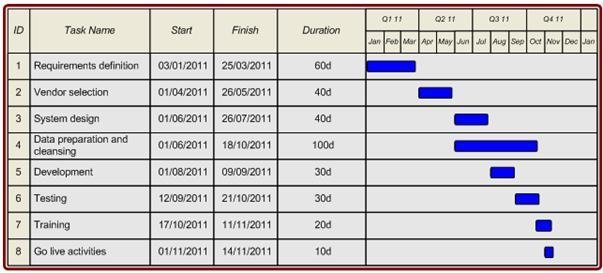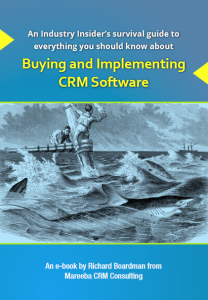I often get asked how long it will take to implement a CRM system, so I though I would use this blog post to try and address that question, and I’ve included an outline project plan for guidance. I think this is a fairly typical CRM project plan for say a 50-100 user implementation using a standard mid-market CRM application, and would be the same regardless of whether this was an ‘in the cloud’ or ‘on premise’ deployment. This would not be for what I saw a Gartner analyst refer to today as a ‘popcorn’ application – something that gets quickly deployed, designed to keep users happy, but which doesn’t add strategic value to the operation of the business. The assumption here is that this is a value enhancing project.

In terms of the above plan the following notes should be considered:
While there is a measure of contingency build into the plan it depicts a time-line it is still fairly aggressive, and doesn’t factor in some of the day to day business realities that can disrupt projects, such as key staff being unavailable, or other business priorities putting a project onto the back burner. Many organisations would struggle to hit these time-lines.
The Project plan does not include the preparatory feasibility and planning activities. I cover this point in more detail in a blog post called truncating the fuzzy front end, but in essence the time elapsed in considering whether to undertake a CRM project can actually dwarf the time it takes to execute once the decision is made.
In the above plan the development time involved is light relative to other activities, which reflects the flexibility and ease of development of the current generation of mid market CRM packages. However, if the requirements gathering and design phases are not comprehensively and competently completed ,they are likely to significantly extend the development phase.
Poor execution in the development phase can significantly extend the user acceptance testing stage . Some vendors will skimp on, or not perform, basic internal testing which again can significantly extend the duration and cost of the stage.
In this plan we have a detailed requirements gathering phase before vendor selection, because we believe that makes for a more cost effective and value enhancing project. Some purchasers of CRM technology will do this after the vendor selection stage. The timing of when this happens however should not effect the duration of the project.
Data preparation and cleansing can be an extremely time consuming phase hence the 100 man days set out in this CRM project plan.
The project plan suggests that the project finishes once the live phase is complete. The reality is that there is normally an intensive piece of ‘on-boarding’ with new users until the desired usage patterns are established and this can last several months and be demanding on internal resources. The plan also assumes all users will go live together, which in practice may not be the case, and on-boarding will need to occur for each group going live.
I suspect the time-lines I’ve described above will run counter to some of the prevailing market wisdom. I will put this down to a number of reasons:
Popcorn projects – as I mentioned above, some CRM deployments are simply about keeping users happy. They aren’t designed to be value-enhancing. I discuss this in more depth in this blog post, but popcorn projects operate on much shorter time-lines.
Vendors are not good with CRM project plans – my experience is that vendors are not good at defining or communicating how long a CRM project should take. I think there are a couple of reasons: firstly they do a lot of popcorn projects and struggle with the rigours of a value-enhancing implementation, and secondly I suspect that undue candour about project time-lines could result in lost sales.
It depends what phases you take into account – when I hear someone say they rolled out a CRM project in say 12 weeks I wonder what they mean? From initial planning and feasibility to satisfactory levels of user adoption? Almost certainly not. From development to the first user going live? Then possibly. If you look at the above project plan, then it’s pretty apparent that the phases you take into account when talking about a CRM roll will have a huge impact on the quoted duration.
I guess the final point to make is that being realistic about CRM project plans is pretty important. There have been many otherwise successful CRM implementations that have been labelled a failure because they couldn’t deliver against an unachievable project plan. Defining sensible time-lines is therefore a key survival tool for would be project managers, teams, and owners.
Further information about Mareeba’s project management services can be found here.
 For further information about structuring a CRM project, download our free ebook – ‘An Industry Insider’s survival guide to everything you need to know about buying and implementing CRM software’
For further information about structuring a CRM project, download our free ebook – ‘An Industry Insider’s survival guide to everything you need to know about buying and implementing CRM software’
![[Facebook]](https://www.mareeba.co.uk/blog/wp-content/plugins/bookmarkify/facebook2.png)
![[Google]](https://www.mareeba.co.uk/blog/wp-content/plugins/bookmarkify/google-plus2.png)
![[LinkedIn]](https://www.mareeba.co.uk/blog/wp-content/plugins/bookmarkify/linkedin2.png)
![[Twitter]](https://www.mareeba.co.uk/blog/wp-content/plugins/bookmarkify/twitter2.png)
![[Pinterest]](https://www.mareeba.co.uk/blog/wp-content/plugins/bookmarkify/pinterest2.png)